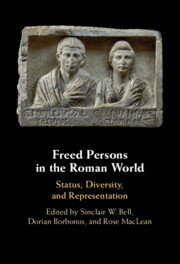Book contents
- Freed Persons in the Roman World
- Freed Persons in the Roman World
- Copyright page
- Contents
- Figures
- Table
- Contributors
- Acknowledgments
- Bibliographical Note
- Introduction
- 1 Permissu decurionum
- 2 Freed Public Slaves in Roman Italy and the Western Provinces
- 3 Fitting in by Decree
- 4 Doubling Up
- 5 The Cost of Ingratitude
- 6 Between Moral Slavery and Legal Freedom
- 7 Framing the Freed Person
- 8 Novel Evidence for Ancient Freed People
- 9 The Affects of Manumission
- General Bibliography
- Index
- References
4 - Doubling Up
Patronal and Familial Designations on Epitaphs*
Published online by Cambridge University Press: 16 May 2024
- Freed Persons in the Roman World
- Freed Persons in the Roman World
- Copyright page
- Contents
- Figures
- Table
- Contributors
- Acknowledgments
- Bibliographical Note
- Introduction
- 1 Permissu decurionum
- 2 Freed Public Slaves in Roman Italy and the Western Provinces
- 3 Fitting in by Decree
- 4 Doubling Up
- 5 The Cost of Ingratitude
- 6 Between Moral Slavery and Legal Freedom
- 7 Framing the Freed Person
- 8 Novel Evidence for Ancient Freed People
- 9 The Affects of Manumission
- General Bibliography
- Index
- References
Summary
On a well-known epitaph from first-century CE Rome, one man commemorates another as his “fellow freedman and, at the same time, dearest companion” (conlibertus idem consors carissimus) (CIL 6, 22355a). The phrase reveals that the men are connected in two ways: by their involuntary legal subjection to the same patron and by their mutual camaraderie. It is the relationship between these two ties, expressed by the Latin idem, that I investigate in this chapter. Over 100 epitaphs employ a form of idem to communicate two distinct but simultaneous bonds, the majority of which were formed through the processes of enslavement and liberation. Employing this corpus of inscriptions, I explore the entanglement of interpersonal ties experienced by freed persons in Roman households. I show that the word libertus/a (freed person), which we often read as a marker of status, is employed on these epitaphs as a relational term, interchangeable and sometimes overlapping with interpersonal ties generated by very different social and legal phenomena, including affection, birth, marriage, and testation.
- Type
- Chapter
- Information
- Freed Persons in the Roman WorldStatus, Diversity, and Representation, pp. 119 - 140Publisher: Cambridge University PressPrint publication year: 2024

